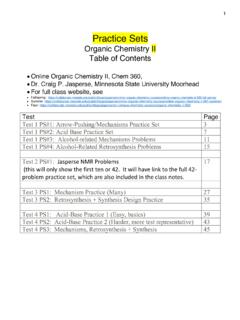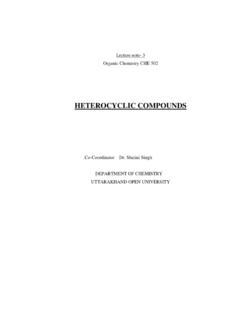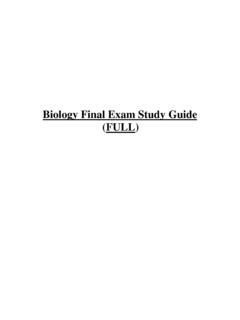Transcription of Biomolecules - NCERT
1 Unit Objectives 14. Biomolecules After studying this Unit, you will be able to explain the characteristics of It is the harmonious and synchronous progress of chemical Biomolecules like carbohydrates, reactions in body which leads to life . proteins and nucleic acids and hormones;. classify carbohydrates, proteins, A living system grows, sustains and reproduces itself. nucleic acids and vitamins on the The most amazing thing about a living system is that it basis of their structures; is composed of non-living atoms and molecules. The explain the difference between pursuit of knowledge of what goes on chemically within DNA and RNA; a living system falls in the domain of biochemistry.
2 Living describe the role of Biomolecules systems are made up of various complex Biomolecules in biosystem. like carbohydrates, proteins, nucleic acids, lipids, etc. Proteins and carbohydrates are essential constituents of our food. These Biomolecules interact with each other and constitute the molecular logic of life processes. In addition, some simple molecules like vitamins and mineral salts also play an important role in the functions of organisms. Structures and functions of some of these Biomolecules are discussed in this Unit. Carbohydrates Carbohydrates are primarily produced by plants and form a very large group of naturally occurring organic compounds. Some common examples of carbohydrates are cane sugar, glucose, starch, etc.
3 Most of them have a general formula, Cx(H2O)y, and were considered as hydrates of carbon from where the name carbohydrate was derived. For example, the molecular formula of glucose (C6H12O6) fits into this general formula, C6(H2O)6. But all the compounds which fit into this formula may not be classified as carbohydrates. For example acetic acid (CH3 COOH) fits into this general formula, C2(H2O)2 but is not a carbohydrate. Similarly, rhamnose, C6H12O5 is a carbohydrate but does not fit in this definition. A large number of their reactions have shown that they contain specific functional groups. Chemically, the carbohydrates may be defined as optically active polyhydroxy aldehydes or ketones or the compounds which produce such units on hydrolysis.
4 Some of the carbohydrates, which are sweet in taste, are also called sugars. The most common sugar, used in our homes is named as sucrose whereas the sugar present 2021 22. in milk is known as lactose. Carbohydrates are also called saccharides (Greek: sakcharon means sugar). Carbohydrates are classified on the basis of their behaviour on hydrolysis. They have been broadly divided into following three groups. (i) Monosaccharides: A carbohydrate that cannot be hydrolysed further Classification of to give simpler unit of polyhydroxy aldehyde or ketone is called a Carbohydrates monosaccharide. About 20 monosaccharides are known to occur in nature. Some common examples are glucose, fructose, ribose, etc.
5 (ii) Oligosaccharides: Carbohydrates that yield two to ten monosaccharide units, on hydrolysis, are called oligosaccharides. They are further classified as disaccharides, trisaccharides, tetrasaccharides, etc., depending upon the number of monosaccharides, they provide on hydrolysis. Amongst these the most common are disaccharides. The two monosaccharide units obtained on hydrolysis of a disaccharide may be same or different. For example, one molecule of sucrose on hydrolysis gives one molecule of glucose and one molecule of fructose whereas maltose gives two molecules of only glucose. (iii) Polysaccharides: Carbohydrates which yield a large number of monosaccharide units on hydrolysis are called polysaccharides.
6 Some common examples are starch, cellulose, glycogen, gums, etc. Polysaccharides are not sweet in taste, hence they are also called non-sugars. The carbohydrates may also be classified as either reducing or non- reducing sugars. All those carbohydrates which reduce Fehling's solution and Tollens' reagent are referred to as reducing sugars. All monosaccharides whether aldose or ketose are reducing sugars. Monosaccharides are further classified on the basis of number of carbon Monosaccharides atoms and the functional group present in them. If a monosaccharide contains an aldehyde group, it is known as an aldose and if it contains a keto group, it is known as a ketose. Number of carbon atoms constituting the monosaccharide is also introduced in the name as is evident from the examples given in Table Table : Different Types of Monosaccharides Carbon atoms General term Aldehyde Ketone 3 Triose Aldotriose Ketotriose 4 Tetrose Aldotetrose Ketotetrose 5 Pentose Aldopentose Ketopentose 6 Hexose Aldohexose Ketohexose 7 Heptose Aldoheptose Ketoheptose Glucose Glucose occurs freely in nature as well as in the combined form.
7 It is present in sweet fruits and honey. Ripe grapes also contain glucose in large amounts. It is prepared as follows: Preparation of 1. From sucrose (Cane sugar): If sucrose is boiled with dilute HCl or Glucose H2SO4 in alcoholic solution, glucose and fructose are obtained in equal amounts. Chemistry 412. 2021 22. +. H. C12 H22O11 + H2O C6 H12O6 + C6 H12O6. Sucrose Glucose Fructose 2. From starch: Commercially glucose is obtained by hydrolysis of starch by boiling it with dilute H2SO4 at 393 K under pressure. +. H. (C6 H10 O5 )n + nH 2 O . 393 K; 2-3 atm nC6 H12 O6. Starch or cellulose Glucose Structure of Glucose is an aldohexose and is also known as dextrose. It is the Glucose monomer of many of the larger carbohydrates, namely starch, cellulose.
8 It is probably the most abundant organic compound on earth. It was assigned the structure given below on the basis of the following evidences: CHO 1. Its molecular formula was found to be C6H12O6. (CHOH)4 2. On prolonged heating with HI, it forms n-hexane, suggesting that all the six carbon atoms are linked in a straight chain. CH2OH. Glucose 3. Glucose reacts with hydroxylamine to form an oxime and adds a molecule of hydrogen cyanide to give cyanohydrin. These reactions confirm the presence of a carbonyl group (>C = O) in glucose. 4. Glucose gets oxidised to six carbon carboxylic acid (gluconic acid). on reaction with a mild oxidising agent like bromine water. This indicates that the carbonyl group is present as an aldehydic group.
9 CHO COOH. Br2 water (CHOH)4. (CHOH)4. CH2OH CH2OH. Gluconic acid 5. Acetylation of glucose with acetic anhydride gives glucose pentaacetate which confirms the presence of five OH groups. Since it exists as a stable compound, five OH groups should be attached to different carbon atoms. 413 Biomolecules 2021 22. 6. On oxidation with nitric acid, glucose as well as gluconic acid both yield a dicarboxylic acid, saccharic acid. This indicates the presence of a primary alcoholic ( OH) group in glucose. CHO COOH COOH. Oxidation Oxidation (CHOH)4 (CHOH)4 (CHOH)4. CH2OH COOH CH2OH. Saccharic Gluconic acid acid The exact spatial arrangement of different OH groups was given by Fischer after studying many other properties.
10 Its configuration is correctly represented as I. So gluconic acid is represented as II and saccharic acid as III. CHO COOH COOH. H OH H OH H OH. HO H HO H HO H. H OH H OH H OH. H OH H OH H OH. CH2OH CH2OH COOH. I II III. Glucose is correctly named as D(+)-glucose. D' before the name of glucose represents the configuration whereas (+)' represents dextrorotatory nature of the molecule. It should be remembered that D' and L' have no relation with the optical activity of the compound. They are also not related to letter d' and l' (see Unit 10). The meaning of D and L notations is as follows. The letters D' or L' before the name of any compound indicate the relative configuration of a particular stereoisomer of a compound with respect to configuration of some other compound, configuration of which is known.

















